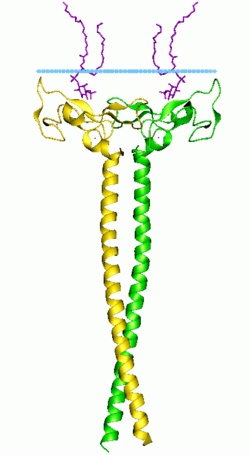From Wikipedia, the free encyclopedia
The gene EEA1 encodes for the 1400 amino acid protein , Early Endosome Antigen 1.
EEA1 localizes exclusively to early endosomes and has an important role in endosomal trafficking. EEA1 binds directly to the phospholipid phosphatidylinositol 3-phosphate through its C-terminal FYVE domain and forms a homodimer through a coiled coil . EEA1 acts as a tethering molecule that couples vesicle docking with SNAREs such as N-ethylmaleimide sensitive fusion protein , bringing the endosomes physically closer and ultimately resulting in the fusion and delivery of endosomal cargo.
Function
EEA1 is a RAB5A effector protein which binds via an N-terminal zinc finger domain and is required for fusion of early and late endosomes and for sorting at the early endosome level.[ 5] [ 6]
Involvement in pathogenesis
Due to the proteins importance in vesicular trafficking, a number of intracellular bacteria prevent EEA1 recruitment to the vacuole. Mycobacterium tuberculosis CamKII .[ 7] Legionella pneumophila [ 8] Legionella longbeachae [ 9]
See also
References
^ a b c GRCh38: Ensembl release 89: ENSG00000102189 – Ensembl , May 2017^ a b c GRCm38: Ensembl release 89: ENSMUSG00000036499 – Ensembl , May 2017^ "Human PubMed Reference:" . National Center for Biotechnology Information, U.S. National Library of Medicine .^ "Mouse PubMed Reference:" . National Center for Biotechnology Information, U.S. National Library of Medicine .^ Mishra A, Eathiraj S, Corvera S, Lambright DG (Jun 2010). "Structural basis for Rab GTPase recognition and endosome tethering by the C2H2 zinc finger of Early Endosomal Autoantigen 1 (EEA1)" . Proceedings of the National Academy of Sciences of the United States of America . 107 (24): 10866–71. doi :10.1073/pnas.1000843107 . PMC 2890723 PMID 20534488 . ^ Barysch SV, Aggarwal S, Jahn R, Rizzoli SO (Jun 2009). "Sorting in early endosomes reveals connections to docking- and fusion-associated factors" (PDF) . Proceedings of the National Academy of Sciences of the United States of America . 106 (24): 9697–702. doi :10.1073/pnas.0901444106 . PMC 2691687 PMID 19487677 . ^ Malik ZA, Thompson CR, Hashimi S, Porter B, Iyer SS, Kusner DJ (Mar 2003). "Cutting edge: Mycobacterium tuberculosis blocks Ca2+ signaling and phagosome maturation in human macrophages via specific inhibition of sphingosine kinase" . Journal of Immunology . 170 (6): 2811–5. doi :10.4049/jimmunol.170.6.2811 PMID 12626530 . ^ Urwyler S, Nyfeler Y, Ragaz C, Lee H, Mueller LN, Aebersold R, Hilbi H (Jan 2009). "Proteome analysis of Legionella vacuoles purified by magnetic immunoseparation reveals secretory and endosomal GTPases" . Traffic . 10 (1): 76–87. doi :10.1111/j.1600-0854.2008.00851.x PMID 18980612 . S2CID 205840762 . ^ Asare R, Abu Kwaik Y (Jun 2007). "Early trafficking and intracellular replication of Legionella longbeachaea within an ER-derived late endosome-like phagosome" . Cellular Microbiology . 9 (6): 1571–87. doi :10.1111/j.1462-5822.2007.00894.x PMID 17309675 . S2CID 11318022 .
External links





